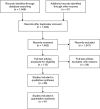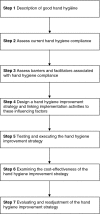A systematic review of hand hygiene improvement strategies: a behavioural approach
- PMID: 22978722
- PMCID: PMC3517511
- DOI: 10.1186/1748-5908-7-92
A systematic review of hand hygiene improvement strategies: a behavioural approach
Abstract
Background: Many strategies have been designed and evaluated to address the problem of low hand hygiene (HH) compliance. Which of these strategies are most effective and how they work is still unclear. Here we describe frequently used improvement strategies and related determinants of behaviour change that prompt good HH behaviour to provide a better overview of the choice and content of such strategies.
Methods: Systematic searches of experimental and quasi-experimental research on HH improvement strategies were conducted in Medline, Embase, CINAHL, and Cochrane databases from January 2000 to November 2009. First, we extracted the study characteristics using the EPOC Data Collection Checklist, including study objectives, setting, study design, target population, outcome measures, description of the intervention, analysis, and results. Second, we used the Taxonomy of Behavioural Change Techniques to identify targeted determinants.
Results: We reviewed 41 studies. The most frequently addressed determinants were knowledge, awareness, action control, and facilitation of behaviour. Fewer studies addressed social influence, attitude, self-efficacy, and intention. Thirteen studies used a controlled design to measure the effects of HH improvement strategies on HH behaviour. The effectiveness of the strategies varied substantially, but most controlled studies showed positive results. The median effect size of these strategies increased from 17.6 (relative difference) addressing one determinant to 49.5 for the studies that addressed five determinants.
Conclusions: By focussing on determinants of behaviour change, we found hidden and valuable components in HH improvement strategies. Addressing only determinants such as knowledge, awareness, action control, and facilitation is not enough to change HH behaviour. Addressing combinations of different determinants showed better results. This indicates that we should be more creative in the application of alternative improvement activities addressing determinants such as social influence, attitude, self-efficacy, or intention.
Figures




References
Publication types
MeSH terms
LinkOut - more resources
Full Text Sources
Medical

